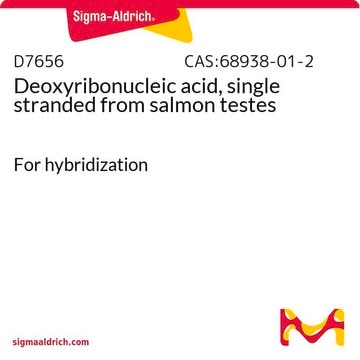L4390
Sodio dodecil solfato
for molecular biology, ≥98.5% (GC)
Sinonimo/i:
Dodecil sodio solfato, Dodecil solfato, Lauril solfato, SDS, Sodio lauril solfato
About This Item
Prodotti consigliati
Grado
for molecular biology
Descrizione
anionic
Saggio
≥98.5% (GC)
Punto di fusione
204-207 °C (lit.)
Anioni in tracce
chloride (Cl-): ≤500 ppm
phosphate (PO43-): ≤10 ppm
Cationi in tracce
Pb: ≤10 ppm
Assorbimento
≤0.3 at 260 nm in solution at 3%
≤0.3 at 280 nm in solution at 3%
Attività estranea
DNase, RNase, none detected
Stringa SMILE
[Na+].CCCCCCCCCCCCOS([O-])(=O)=O
InChI
1S/C12H26O4S.Na/c1-2-3-4-5-6-7-8-9-10-11-12-16-17(13,14)15;/h2-12H2,1H3,(H,13,14,15);/q;+1/p-1
DBMJMQXJHONAFJ-UHFFFAOYSA-M
Cerchi prodotti simili? Visita Guida al confronto tra prodotti
Applicazioni
Avvertenze
Danger
Indicazioni di pericolo
Consigli di prudenza
Classi di pericolo
Acute Tox. 4 Oral - Aquatic Chronic 3 - Eye Dam. 1 - Skin Irrit. 2
Codice della classe di stoccaggio
11 - Combustible Solids
Classe di pericolosità dell'acqua (WGK)
WGK 2
Punto d’infiammabilità (°F)
338.0 °F
Punto d’infiammabilità (°C)
170 °C
Dispositivi di protezione individuale
Eyeshields, Faceshields, Gloves, type P3 (EN 143) respirator cartridges
Certificati d'analisi (COA)
Cerca il Certificati d'analisi (COA) digitando il numero di lotto/batch corrispondente. I numeri di lotto o di batch sono stampati sull'etichetta dei prodotti dopo la parola ‘Lotto’ o ‘Batch’.
Possiedi già questo prodotto?
I documenti relativi ai prodotti acquistati recentemente sono disponibili nell’Archivio dei documenti.
I clienti hanno visto anche
Il team dei nostri ricercatori vanta grande esperienza in tutte le aree della ricerca quali Life Science, scienza dei materiali, sintesi chimica, cromatografia, discipline analitiche, ecc..
Contatta l'Assistenza Tecnica.








